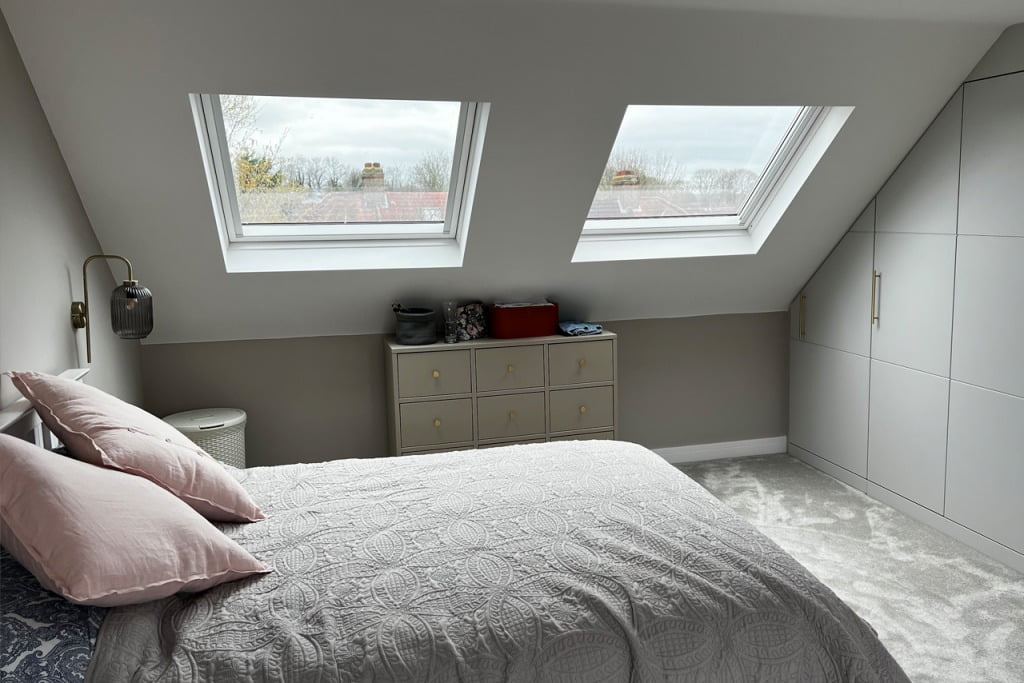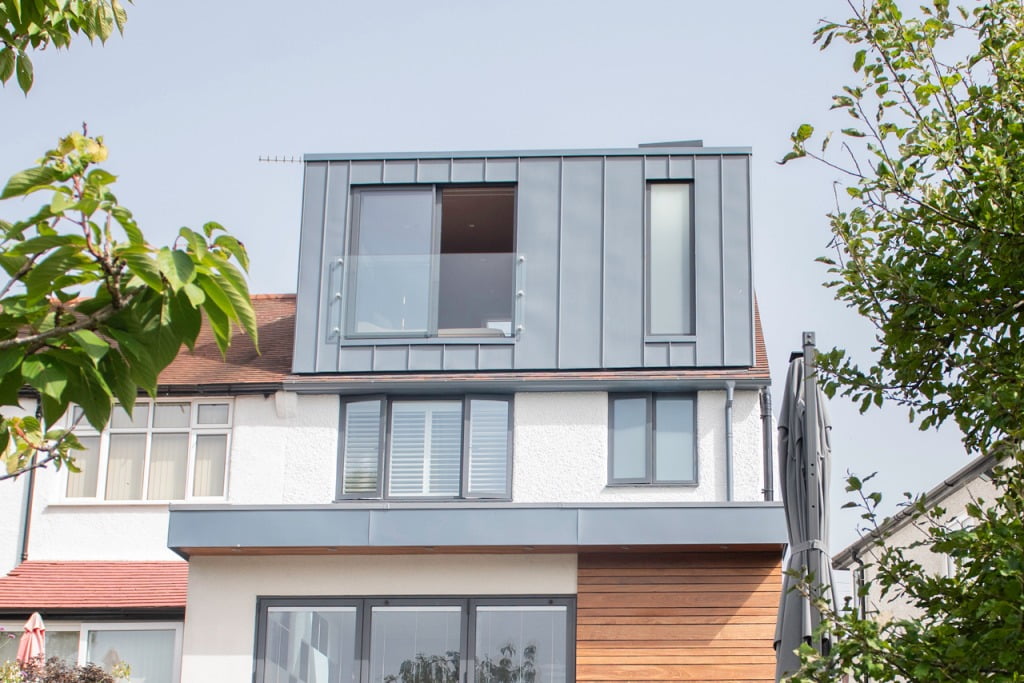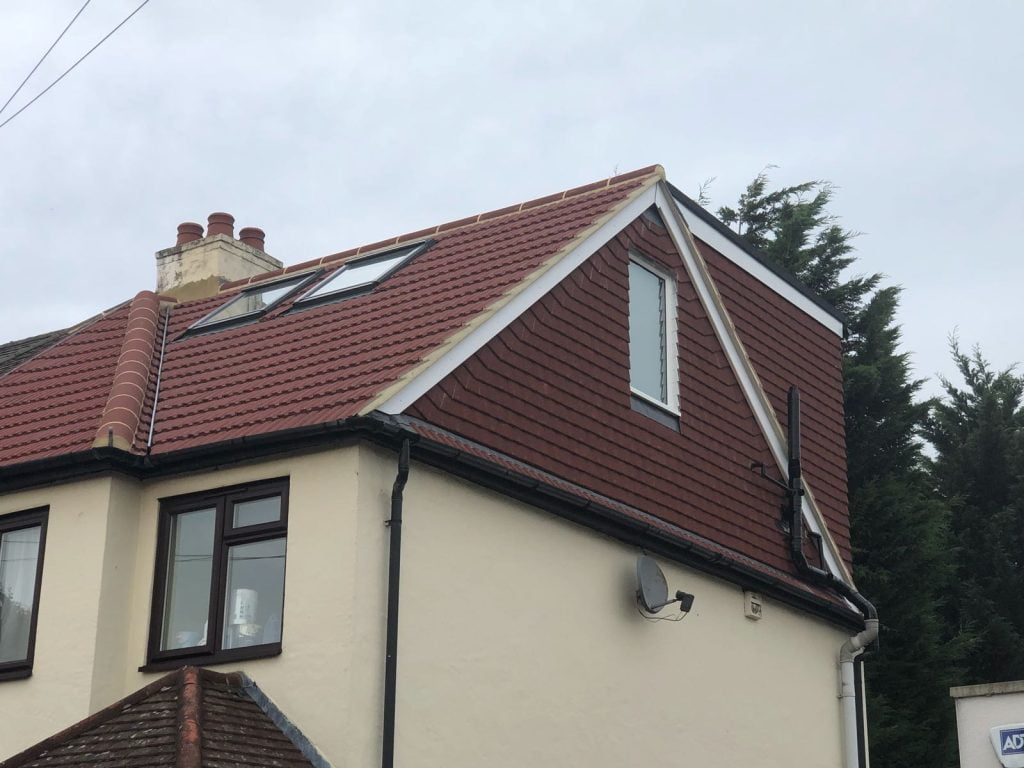Over the years, we have transformed countless attics from dusty storage areas into vibrant new parts of our clients’ homes. Loft conversions offer a unique way to unlock valuable living space in your home, whether you’re looking for a master bedroom, a home office, or a playroom. In this guide, we’ll explore the most popular types of loft conversions and provide in-depth details to help you decide which one suits your home best. Here’s what we’ll cover:
- Velux loft conversion
- Dormer loft conversion
- Hip to Gable loft conversion
- Mansard loft conversion
- L-shaped loft conversion
Each of these conversions can be tailored to fit your property’s structure, budget, and design aspirations. Get a Free Consultation Today!
Understanding Loft Conversion Types
Converting your loft into a livable space can unlock up to 30% more space in your home. It’s often a more economical solution than moving and can significantly increase the value of your property. Let’s take a closer look at the different loft conversion types, the costs involved, and the specific benefits each offers.
Velux Loft Conversions: The Light-Filled Solution

Velux loft conversions are one of the most cost-effective ways to convert your loft. This type of conversion involves adding Velux windows to your existing roof structure without changing its shape. This allows for plenty of natural light and ventilation while keeping the project simple.
- Key Benefits:
- Quick to install (often completed in 4-6 weeks)
- No major structural work required
- Lower costs compared to other conversions
- Does not alter the external appearance of the home
- Structural Considerations: For Velux conversions, ensuring adequate headroom is crucial. The minimum height required is around 2.2 meters. If the height is lower, alternative solutions like dormer or mansard conversions may be necessary.
- Energy Efficiency: Velux windows come with double or triple glazing options, helping to improve your home’s insulation. Consider adding energy-efficient insulation to the roof during the conversion to save on long-term energy costs.
Best for: Homes with sufficient existing headroom and no need for major structural changes.Estimated Cost: £15,000 – £20,000
Planning Permission: Typically not required, as it falls under permitted development rights.
Timeline: 4-6 weeks.
Dormer Loft Conversions: Creating Extra Headroom

A dormer loft conversion extends your roof vertically to create more headroom and usable floor space. This type of conversion projects outward from the existing roof and typically includes large windows for added light and ventilation.
- Key Benefits:
- Adds more headroom and usable space
- Ideal for creating multiple rooms (e.g., bedroom, office)
- Increases natural light and airflow
- Cost Breakdown:
- Construction costs: £25,000 – £50,000 (varies based on size and location)
- Planning permission: Dormers often require planning permission due to changes in the roofline.
- Structural work: Reinforcing existing roof structures and ensuring the dormer is aligned with the load-bearing walls may increase costs.
- Potential Challenges: Dormer conversions can encounter issues with planning permission, especially in conservation areas. It’s crucial to consult with your local authority to ensure compliance with building regulations.
- Energy Efficiency: Dormer conversions offer the opportunity to add significant insulation, which can lead to energy savings. Proper insulation reduces heat loss, keeping your loft warm in winter and cool in summer.
Best for: Properties needing extra headroom and space.
Estimated Cost: £25,000 – £50,000
Planning Permission: Usually required due to changes in the roofline.
Timeline: 6-10 weeks.
Hip-to-Gable Loft Conversions: Expanding Sloping Roofs

For homes with sloping roofs on all sides, a hip-to-gable conversion maximizes the loft space by extending one or more of the sloping sides into vertical gable walls. This creates additional vertical space and significantly increases the usable area of your loft.
- Key Benefits:
- Maximizes space in homes with hipped roofs
- Great for adding larger rooms like a master bedroom or a spacious home office
- Offers a more seamless exterior appearance when blended with the existing roof
- Cost Breakdown:
- Structural work: Extending the roof requires significant structural changes, such as removing part of the existing roof and reinforcing the walls.
- Planning permission: Required in most cases due to the changes in the roof shape and structure.
- Energy Efficiency: You can improve energy efficiency by installing high-performance insulation during the construction phase, which helps retain heat and minimize energy costs.
- Potential Challenges: Hip-to-gable conversions often require complex structural work, which can drive up costs. Working with an experienced contractor is essential to avoid unforeseen complications.
Best for: Homes with hipped roofs looking for a spacious and open layout.
Estimated Cost: £30,000 – £60,000
Planning Permission: Typically required due to the significant alteration of the roof structure.
Timeline: 8-12 weeks.
Mansard Loft Conversions: The Classic Space Enhancer

A mansard loft conversion changes the roof’s structure to create a nearly vertical wall on one or both sides and a flat roof on top. This maximizes the interior space, often turning the attic into a full-fledged additional storey.
- Key Benefits:
- Maximizes usable space, ideal for multiple rooms or large open-plan layouts
- Ideal for urban homes, especially in high-demand areas like London
- Can enhance property value by 20-24%
- Cost Breakdown:
- This is one of the most expensive conversion types, with costs ranging from £45,000 to £70,000 depending on complexity.
- Structural changes are extensive, requiring roof alterations, reinforcement of existing structures, and re-roofing.
- Planning permission is always required, as the changes are substantial.
- Potential Challenges: Mansard conversions often face planning permission hurdles, especially in conservation areas. The complex structural work can also lead to extended timelines and increased costs.
Best for: Homeowners looking to maximize space and value.
Estimated Cost: £45,000 – £70,000
Planning Permission: Always required due to significant structural changes.
Timeline: 10-12 weeks.
L-Shaped Loft Conversions: The Mid-Terrace Marvel
An L-shaped loft conversion is designed for properties with an L-shaped roof, such as Victorian terraces. This conversion utilizes the space over the rear extension, creating a large, versatile area for multiple uses.
Key Benefits:
- Adds substantial additional space, often enough for two rooms or an open-plan layout
- Maximizes floor space for homes with unique roof shapes
- Ideal for adding a master bedroom, playroom, or even a second living area
Cost Breakdown:
- Costs typically range from £40,000 to £65,000 depending on the complexity.
- Structural work involves extending over the rear extension and blending the new loft space with the existing structure.
- Planning permission is often required due to the complexity of the design.
Potential Challenges: L-shaped conversions require careful planning to ensure that the space is used efficiently, and they often need planning permission due to the significant structural changes.
Best for: Mid-terrace homes, especially Victorian or Edwardian properties.
Estimated Cost: £40,000 – £65,000
Planning Permission: Usually required due to the structural changes involved.
Timeline: 10-12 weeks.
Planning for Your Loft Conversion
Once you’ve chosen the ideal type of loft conversion for your home, it’s essential to navigate the planning and regulatory landscape. Permitted development rights often allow loft conversions without the need for full planning permission, but there are specific rules to follow.
When Is Planning Permission Required?
Planning permission is required when:
- The conversion exceeds volume allowances (40 cubic meters for terraced homes, 50 cubic meters for detached or semi-detached homes).
- Front-facing windows or balconies are added.
- The conversion is in a conservation area or impacts neighboring properties.
Understanding Permitted Development Rights
Loft conversions that meet the following criteria usually don’t require planning permission:
- The extension doesn’t exceed the plane of the existing roof slope facing any highway.
- The peak height doesn’t exceed that of the existing roof.
- A minimum setback from the original eaves must be maintained at no less than 20 centimeters.
Pro Tip: Securing a Lawful Development Certificate is always advisable to confirm that your project complies with legal requirements.
Maximising Your Loft Space
Having determined the kind of loft conversion and dealt with the planning aspects, what’s next in maximising our loft space? The answer revolves around focusing on design enhancements for improved utility as well as ensuring an abundance of natural light and airflow.
It’s time to jump into these vital components that will elevate your loft from just a regular living space to something truly special!
Design Considerations for Added Functionality
The success of a loft conversion heavily relies on its design. Here are some ingenious approaches to consider in order to enhance the use and appeal of a loft space:
- Opting for built-in storage options such as custom wardrobes, under-eave compartments, and integrated shelving helps efficiently use the distinctive shapes and challenging areas typical of lofts.
- Implementing design strategies that create an impression of more vertical space is beneficial. Tall bookcases or drapery reaching from floor to ceiling can achieve this effect.
- Incorporating architectural features like skylights or Juliet balconies also contributes distinctiveness to the converted area.
Such thoughtful design elements not only enhance functionality but also elevate the overall beauty of your loft conversion.
Embracing a minimalist interior decorating scheme will maintain an airy atmosphere throughout your newly transformed attic. To achieve minimalism with practicality, consider these suggestions:
- Employ mirrors judiciously around the room, which reflect both natural light and views across spaces, thus broadening visual dimensions.
- Choose furniture that does double duty. Examples include couches converted into beds or tables offering concealed storage capacity.
- Thoughtful positioning of furnishings beneath angled ceilings – or applying separators – can optimise living space efficiency in a creatively adapted attic area.
Incorporating Natural Light and Ventilation
Ensuring a loft space is filled with ample natural light and adequate ventilation is essential for creating an environment that’s both welcoming and pleasant. By installing sizable Velux windows, you can inundate your loft conversion with daylight while maintaining the exterior facade of your home intact. Windows on the side should have frosted glass to maintain privacy and must be positioned sufficiently high off the floor – typically no less than 1.7 meters.
Adding unique elements like a Velux Cabrio Balcony can bring versatility as well as elegance, along with a hint of alfresco living inside your home. Loft conversions featuring gabled dormers that include expansive windows or French doors are excellent ways to enhance natural lighting within the area, making it feel more spacious and luminous.
Loft Conversion Benefits and Potential
Loft conversions are not only about augmenting your home’s living space and visual charm. They also present substantial advantages that can amplify both the value and utility of your house.
We will explore the ways in which transforming your loft can elevate the monetary value of your property while simultaneously creating spaces that enrich your way of life.
Boosting Property Value with a Loft Extension
Are you aware that a skillfully executed loft conversion can raise the value of your home by around 20%, and even more so – up to 24.5% in areas of high real estate demand such as London? Opting for a Dormer loft conversion is an economically viable choice, providing substantial additional living space without significantly expanding the budget, making it very appealing to prospective purchasers.
The extent to which a property’s value is elevated due to a loft conversion hinges on both existing market trends and the particular attributes of the home. Take into account that conversions maximise attic utility or incorporate roof windows to allow ample natural light to stand out on the market by boosting both allure and prospective resale value.
Creating Lifestyle-Enhancing Spaces
The flexibility of loft conversions presents a significant advantage, as they can be customised to suit the specific tastes and requirements of individuals or families. Lofts can be adeptly converted into various types of rooms, including:
- Bedrooms
- Home gyms
- Playrooms
- Areas for entertainment
- Distinctive spaces that resonate with an individual’s way of life
Embedding personal design flair within a loft conversion is crucial in fashioning an area that not only serves its purpose but also aligns with the homeowner’s visual desires.
Real-Life Loft Conversion Examples
Exploring actual cases of loft conversions can provide a clear picture of their potential to turn your attic into practical and visually appealing living spaces. Despite the theoretical allure, seeing these transformations in reality truly demonstrates how effectively they can enhance the usability and aesthetics of an underutilised loft.
Case Study: A Bright and Airy Velux Conversion
A Velux conversion in a detached house ingeniously repurposed the formerly idle attic area into a vibrant and well-lit living space, which now encompasses two freshly created bedrooms, an accommodating bathroom, and an expansive landing zone. These rooms are adorned with warm and neutral tones that accent their open and luminous ambience.
In maximising the use of living space, the master bedroom is outfitted with a built-in wardrobe alongside a dedicated dressing section. To elevate the home’s aesthetic appeal and contribute to its distinct charm, an oak staircase was fitted as a tasteful addition to the residence.
Case Study: A Spacious Dormer Conversion in a Semi-Detached Property
Transforming a semi-detached home, the introduction of a dormer conversion within the attic area provided an expanded living environment complete with an added bedroom. The suitability of this property for such enhancement was due to its pre-existing loft that boasted ample headroom, ideal for accommodating a pitched roof dormer.
This modification yielded considerable additional floor space and furnished the residence with another bedroom, thereby substantially improving its utility. A window positioned at the rear elevated both the spaciousness and illumination of this newly crafted bedroom.
Key Takeaways
- Loft conversions can unlock up to 30% more space and are a cost-effective, less stressful alternative to moving, with various types such as Velux, Dormer, Hip to Gable, Mansard, and L-shaped conversions each offering different benefits and suitability based on home design and budget.
- Planning permission for loft conversions hinges on compliance with permitted development rights; for instance, volume allowances differ for terraced and detached/semi-detached homes, and factors like the position of dormers and roof extensions are regulated to minimise the impact on neighbouring properties.
- A well-executed loft conversion can enhance a home’s value by up to 20% and create multipurpose living spaces that cater to personal preferences, such as additional bedrooms, home offices, or entertainment areas. These spaces should emphasise natural light, ventilation, and smart design choices.
To sum up, transforming your home’s unused attic through a loft conversion can substantially enhance your living area. Whether you choose Velux, Dormer, Hip to Gable, Mansard or L-shaped conversions, each brings distinct advantages that contribute to the appeal and functionality of your space. Key factors such as permitted development rights and planning permission need careful consideration. Effective use of design elements like natural light can make all the difference in elevating the success of your loft project. Don’t delay – embark on realising the full potential of your loft with a well-planned conversion now!
Frequently Asked Questions
What are the different types of loft conversions?
Five primary types of loft conversion exist, namely: roof light/Velux conversions, dormer conversions, hip-to-gable conversions, mansard conversions and L-shaped.
What is the cheapest type of loft conversion?
Opting for a Velux conversion is the most budget-friendly choice when considering a loft conversion. This process entails installing roof windows into your existing loft space to allow for natural light and improved airflow, thus presenting an uncomplicated and economical solution.
This type of loft renovation stands out as an affordable alternative to expand the living area within your residence.
What is a Type 3 loft extension?
A Type 3 loft extension offers an expansion that includes a complete second-floor addition, featuring living accommodations within the loft on the third floor. This design is carefully crafted to blend seamlessly with the original materials and structure.
Such an extension provides extra living space situated under a pitched roof, making use of the loft area for added room.
What lofts Cannot be converted?
The potential for a loft conversion exists in many homes. This is contingent on various aspects such as the ridge height, the amount of space accessible, and any limitations due to conservation or heritage considerations.
Typically, if the vertical distance from the loft floor to its apex – the highest point – is under 2.2 meters, it may not be conducive for a conversion.
Do all loft conversions require planning permission?
Loft conversions that fall outside the parameters of permitted development will necessitate planning permission. Conversely, those meeting these conditions do not require such authorisation.
